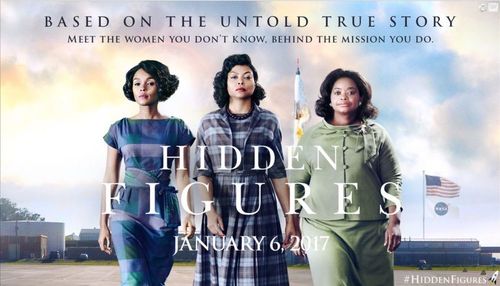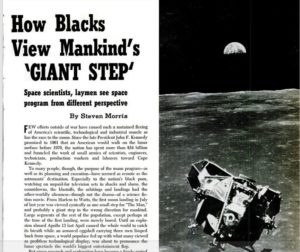


By Paul Kersey
02/07/2017
[See Also: Hyped Figures: John Glenn And the PC Myth of Katherine Johnson — Unsung Black Women Were NOT What Got US To The Moon; Why Not A Movie About Jack Crenshaw — The White Man Who Actually Did What HIDDEN FIGURES Credits To Black Women; America Should Be Ashamed: Why Isn’t HIDDEN FIGURES About “Nazi Scientist” Arthur Rudolph?].

Octavia Spencer, one of the stars of the much-hyped movie Hidden Figures, just told The New York Times that I was one of only “a few idiots” skeptical of the myth that black women got America to the moon. And after my initial expose on VDARE.com, a black female doctoral student wrote me and claimed even though portions of the story were fictionalized, it didn’t matter:
From:Hello,
The article doubting the truths of Hidden Figures characters or rather, the poor attempt at click bait- is dripping in White tears. Why take the time to write about the non existent reverse racism? You surely could have summarized the article in a 140 character or less tweet! "Dr. Jack Crenshaw helped too!" and "Katherine Johnson doesn’t even look Black! She is probably White!" And let’s not forget "Few Black Women getting us to the moon is laughable!"
I had hoped your particular brand of racism was dying out with the last of the "it was a different time" racists, but your article made me understand that as a Black Female Doctoral student, there will still be those who doubt my credibility due to the amount of melanin in my skin.
I am hopeful you will educate yourself on your many, obvious privileges and use it to inform others with a similar rhetoric on why articles like these cause harm that goes further than my career. While I will concede that Hollywood’s attempts to sell tickets fictionalizes portions of the story, I would choose to take a fictional portrayal of real life people over complete erasure any day.
Best,
Tiffany
January 12, 2017 Emphasis added
Of course, all this begs the obvious question how “fictional” Hidden Figures really is.
Contrary to myth, America was already thoroughly race-whipped when NASA was in its heyday. For example, a Washington Post reportorial entitled “Racism, Sexism, and Space Ventures” back in November 24, 1973, was a stereotypical lament that NASA lagged behind other federal agencies when it came to employing non-whites:
From 1966 to June of this year, NASA’s minority employment increased by only 1.1 percent. The effectiveness of the seven year NASA effort in this field can be gauged by contrasting its current 5.19 percent minority employment figure with the government wide figure of 20 percent. [Racism, Sexism, and Space Ventures, [Pay Archive]Washington Post, November 24, 1973 (PDF)]

Black leaders were intensely critical. As man was about to land on the moon, the black magazine Jet was condemning the space program for using money which could be better spent on welfare programs for blacks. [Blacks Scarce as Men on Moon at Launch, by Simeon Booker, Jet, July 31, 1969]
Not to be outdone, Ebony magazine published an editorial comparing white men going to the moon to Columbus’s voyage to the New World, which led "to one of the most infamous and long lasting rapes of all history" [Giant Leap for Mankind?, Ebony, October 1969]
The prior month, Ebony had reported that blacks opposed what they thought was a misallocation of white taxpayer dollars better suited for ameliorating poverty in black communities and Africa:
From Harlem to Watts, the first moon landing in July of last year was viewed cynically as one small step for "The Man," and probably a giant leap in the wrong direction for mankind. Large segments of the rest of the population, except perhaps at the time of the first landing, were merely bored.[How Blacks View Mankind’s 'Giant Step': Space scientists, laymen see space program from different perspective, by Steven Morris Ebony, September 1970, p. 33]

On July 16, 1969, Ralph Abernathy — the heir to Martin Luther King’s civil rights shakedown machine — rode a mule cart, with three mules, along with 150 other poor black people to protest NASA’s launch to the moon. [Protesters, VIPS Flood Cape Area, by William Greider, Washington Post, July 17, 1969]
Even Time and Newsweek were upset by the lily-white nature of the moon launch. Time, for example, asked “Is the moon white?”
“On launch day,” the magazine continued, “the VIP grandstand was a miniature Who’s Who of white America; it was disturbing to notice that black faces were scarce.” Opposition to the expensive space program was especially strong inside the nation’s African American community. “Texas, with its oil wells, large farms, and now space center of the world, symbolizes the affluent America,” said Herbert James, the black field director of the National Welfare Rights Organization, “but there exists in this great state a despicable amount of poverty. Starvation and hunger are taking place within miles of the space center.”[The Columbia History of American Television, by Gary Edgerton, p.272-273]

In long run, these black leaders got what they wanted. America gave up exploring the heavens to spend untold trillions pretending race didn’t exist.
Now, we are expected to fall on our knees to praise the obviously inflated contributions of three black women canonized in a film which has already won a Screen Actors Guild award and will no doubt win an Academy Award.
Hidden Figures was made with the painfully-obvious agenda of delegitimizing the contributions of white scientists, physicists, engineers, mathematicians, project managers, aviation experts and rocket scientists. Instead, America’s greatest triumph evidently hinged on unknown black women manually calculating trajectories already confirmed by computers and a white man named Jack Crenshaw.
But even in 1969, NASA and the federal government would have been proud to show off any black contributions to the moon landing. By highlighting black contributions to the Apollo program, NASA could have kept blacks from singing songs like Gil Scott-Heron’s “Whitey on the Moon” (which bemoaned how a rat could bite the black singer’s sister while white people were on the moon).
But this didn’t happen.
Why didn’t someone from NASA bring up Katherine Johnson back then to counter this negative publicity?
Simple. Her contributions were so insignificant no one with NASA noticed them enough to highlight them.
Which is why Hidden Figures matters and must be lavished with awards and praise. It creates a new narrative, completely devoid of truth, about black participation in man’s greatest achievement even in the face of discrimination. And it’s a narrative that a certain audience — it should be noted women made up 64 percent of the opening weekend audience, with minorities representing 57 percent of those seeing the film — want to hear [Hidden Figures cast celebrates as film hits No. 1, by Joey Nolfi, Entertainment Weekly, January 9, 2017].
Yet surely audiences wanted to believe it in 1969 as well. Katherine Johnson, were her contributions so vital, could have been the much-needed minority public relations asset to parade around to the media back then.
But her value as a symbol was limited — because her contributions were trivial.
And she can only be brought up now because the real truth about black opposition to the space program has been hidden in plain sight.
Paul Kersey is the author of the blog SBPDL, and has published the books SBPDL Year One, Hollywood in Blackface and Escape From Detroit, Opiate of America: College Football in Black and White and Second City Confidential: The Black Experience in Chicagoland. His latest book is The Tragic City: Birmingham 1963-2 013.